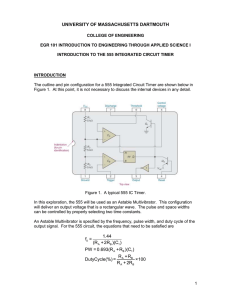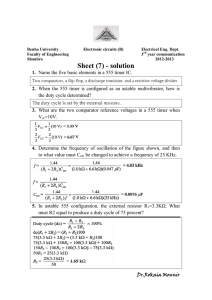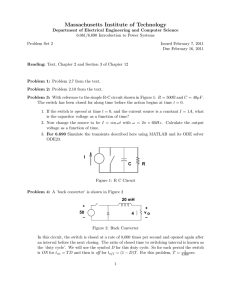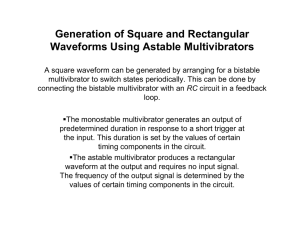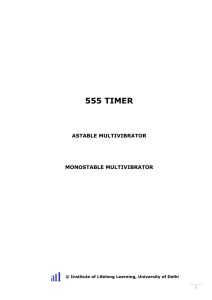Exploration of the 555 Integrated Circuit Timer
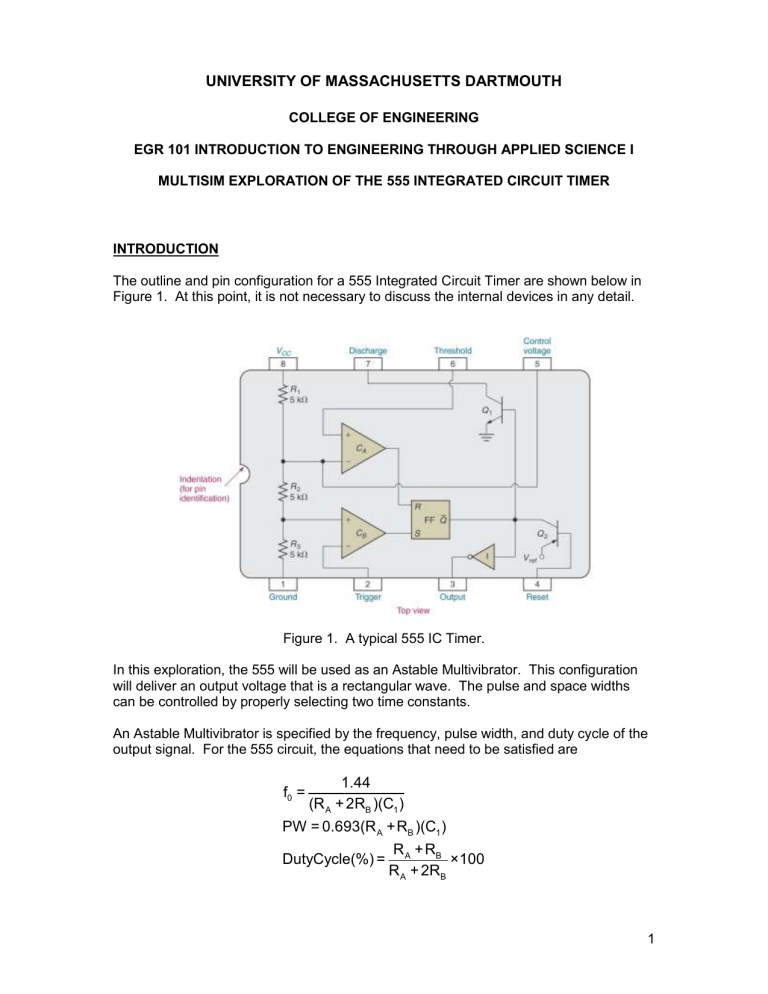
UNIVERSITY OF MASSACHUSETTS DARTMOUTH
COLLEGE OF ENGINEERING
EGR 101 INTRODUCTION TO ENGINEERING THROUGH APPLIED SCIENCE I
MULTISIM EXPLORATION OF THE 555 INTEGRATED CIRCUIT TIMER
INTRODUCTION
The outline and pin configuration for a 555 Integrated Circuit Timer are shown below in
Figure 1. At this point, it is not necessary to discuss the internal devices in any detail.
Figure 1. A typical 555 IC Timer.
In this exploration, the 555 will be used as an Astable Multivibrator. This configuration will deliver an output voltage that is a rectangular wave. The pulse and space widths can be controlled by properly selecting two time constants.
An Astable Multivibrator is specified by the frequency, pulse width, and duty cycle of the output signal. For the 555 circuit, the equations that need to be satisfied are
1.44
f =
0
B 1
B 1
DutyCycle(%) = B ×100
B
1
PROCEDURE
This laboratory should be done in pairs .
Use Multisim to simulate the 555 Timer circuit shown below.
Figure 2. A 555 Timer connected as an Astable Multivibrator
Choose your individual resistor values according to the following:
R
A
= A kΩ, where A is the first non-zero digit in one team member’s UMD ID number
R
B
= B kΩ, where B is the last non-zero digit in the other team member’s UMD ID number
Choose the value of the capacitor C
1 to be your group number in μF.
Calculate the frequency, pulse width, and duty cycle from the equations on page 1.
Simulate your design in MultiSim. Connect the oscilloscope to display the waveforms of the 555 output voltage (the voltage at pin #3) on Channel A and the voltage across the capacitor (the voltage at pin #6) on Channel B. Connect the frequency counter to pin#3 to measure the frequency of the 555 output voltage. From the instrument measurements, determine:
The period of the output voltage,
T he “on” time, or pulse width, of the output voltage, and
The frequency of the output voltage.
2
Using Excel, prepare a table to record the calculated and measured values of frequency, pulse width, and duty cycle for these component values.
Compare the calculated and measured values of the frequency, pulse width, and duty cycle, and comment on your results.
As time permits, repeat the exploration by first halving both resistances, then doubling them while the capacitor value remains unchanged (you must do at least one condition different from the original). Be sure to make note of how the frequency, pulse width, and duty cycle change (both in the simulation and in your calculations) as a function of these resistance values!
RESULTS TO BE HANDED IN – ONE SET PER GROUP OF 2
For the original component values:
Circuit diagram of the 555 Astable Multivibrator
Oscilloscope and frequency counter printouts
For each set of component values:
Calculations of frequency, pulse width, and duty cycle
Excel table containing the calculated and measured results
Comparison of calculated and measured results
For the “overall” exploration:
Conclusions about the changes in the 555 output voltage as a function of the resistances
R
A
and R
B
.
3
